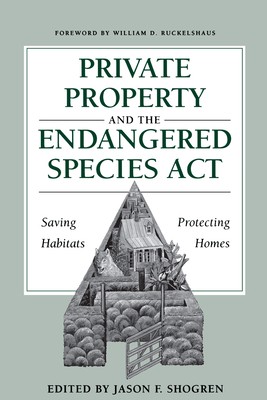
- We will send in 10–14 business days.
- Publisher: University of Texas Press
- ISBN-10: 029277737X
- ISBN-13: 9780292777378
- Format: 15.2 x 22.8 x 1.1 cm, softcover
- Language: English
- SAVE -10% with code: EXTRA
Private Property and the Endangered Species ACT (e-book) (used book) | bookbook.eu
Reviews
Description
Our whole nation benefits from the preservation of natural habitats and their diversity of animal and plant species--yet small groups of private landowners often bear most of the costs of setting land aside for conservation purposes. This imbalance has generated many conflicts since the passage of the Endangered Species Act in 1973 and remains one of the most controversial issues to be resolved as the ESA makes its way through Congress for reauthorization.
To provide policy makers, landowners, and other stakeholders in the ESA debates with impartial baseline information, this book offers multidisciplinary perspectives on the role that private property plays in protecting endangered species in the United States. The opening chapter traces the evolution of the ESA and set forth the parameters of the debate over regulation of private property. Four subsequent chapters explore the judicial and economic implications of ESA and suggest how issues of scale and diversity affect the implementation of the ESA on private property. The volume concludes with eight principles to help frame the ongoing ESA reauthorization debate, developed by the University of Wyoming's Institute for Environment and Natural Resources Policy Board, the sponsor of the research presented in this book.
EXTRA 10 % discount with code: EXTRA
The promotion ends in 18d.04:31:17
The discount code is valid when purchasing from 10 €. Discounts do not stack.
- Publisher: University of Texas Press
- ISBN-10: 029277737X
- ISBN-13: 9780292777378
- Format: 15.2 x 22.8 x 1.1 cm, softcover
- Language: English English
Our whole nation benefits from the preservation of natural habitats and their diversity of animal and plant species--yet small groups of private landowners often bear most of the costs of setting land aside for conservation purposes. This imbalance has generated many conflicts since the passage of the Endangered Species Act in 1973 and remains one of the most controversial issues to be resolved as the ESA makes its way through Congress for reauthorization.
To provide policy makers, landowners, and other stakeholders in the ESA debates with impartial baseline information, this book offers multidisciplinary perspectives on the role that private property plays in protecting endangered species in the United States. The opening chapter traces the evolution of the ESA and set forth the parameters of the debate over regulation of private property. Four subsequent chapters explore the judicial and economic implications of ESA and suggest how issues of scale and diversity affect the implementation of the ESA on private property. The volume concludes with eight principles to help frame the ongoing ESA reauthorization debate, developed by the University of Wyoming's Institute for Environment and Natural Resources Policy Board, the sponsor of the research presented in this book.


Reviews